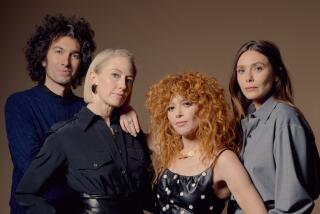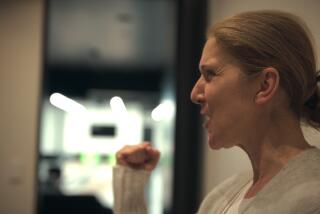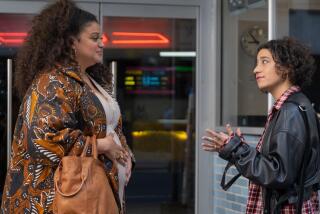On The Set : Hot 60-Year-Old Copy : THE STORY OF THE DIONNE QUINTUPLETS ARRIVES ON CBS AS ‘MILLION DOLLAR BABIES’
- Share via
MONTREAL, CANADA — Beau Bridges, wearing the kind of white medical smock worn by the doctor who delivered the world’s first surviving quintuplets, makes his way into a nursery that might have floated up from a mother’s gauziest dream.
Here are five perfect beds, with chenille spreads in five perfect pastels and little matching bedside lamps, animal stencils running around the top of the walls, and in the middle of it all, five identical postcard-perfect little girls.
“And are my angels happy tonight?” Bridges asks, looking walrus-like with his extra stomach padding. “Yes, Dr. Dafoe,” Annette, Cecile, Yvonne, Emilie and Marie chant in unison.
The two-part CBS movie that Bridges is shooting is called “Million Dollar Babies,” but that’s an understatement. The tiny Dionne infants, born in May, 1934, to impoverished French-Canadian parents in a remote Ontario town, so endeared themselves to America that they generated more than $100 million as a tourist attraction known as Quintland (built across from the Dionnes’ hardscrabble farm).
Airing more than 60 years after the quintuplets were born, “Million Dollar Babies” can be looked at as a modern-day parable on media hype in its formative years. On a more inspirational level, the infants, by their very survival, became a symbol of hope to a continent mired in depression.
Bridges plays Dr. Allan Roy Dafoe, the self-promoting doctor who delivered the five girls and became their legal guardian. In his path to celebrityhood, the country doctor met President Franklin D. Roosevelt and was interviewed by Walter Winchell.
Later, in Bridges’ dressing room, an old recording of Winchell interviewing the real Dafoe (the sound is as scratchy as the rough woolen trousers Bridges is wearing) is playing. Bridges, a demon for authenticity, is imitating the cadences of Dafoe’s voice.
Authenticity was much on his mind when he first read the script for the $10-million movie. “I didn’t know anything about this when i read the script,” Bridges says. “Didn’t even know if it was a true story. Then I got to the bit about Quintland and I thought, ‘No, that can’t be true. They made it up.’ ”
But it was all the truth, including an unpleasant truth that the Dionne sisters’ adoring public didn’t know at the time: that they had been virtually kidnaped from their parents and were being raised by child-development theorists who programmed every moment of their days, tying their hands at night so they couldn’t touch their genitals.
When they became adults, they retreated from the world together to live in seclusion. None ever married. The three still alive today--Annette, Cecile and Yvonne--emerged on their 60th birthday last spring to give a single well-paid interview to a tabloid.
“Million Dollar Babies,” written by Toronto’s Suzette Couture, places the story in the context of Canada in the 1930s. French farmers such as Elzire and Oliva Dionne were treated by English Canadians much as white Americans of the era treated blacks.
Even an idealistic doctor like Dafoe, Bridges says, thought the French were “exotic savages.” That’s the only way, he says--still wrestling with the complexity of the character--that Dafoe participated in the “unthinkable” crime of “letting the government take away the babies.”
He wasn’t the only player in on the act. Kate Nelligan appears as Helena Reid, a famous American radio “sob sister” who saw the quints’ media possibilities right away. Using her medium, she framed the father as a villain, and when the public tired of that, she rehabilitated him and turned her scorn on the good doctor.
Montreal director Christian Duguay (who worked on “Snowbound” for CBS) hired two Quebec actors to play the parents. Celine Bonnier, a fearless stage actress with an earth-mother presence, says she can relate to her character partly through the fact that both have an imperfect understanding of English.
“When I am tired, and having a hard time understanding English,” says Bonnier, “I think how it must have been like that for Mrs. Dionne too. It’s bad enough that she lost her babies, but she lost them to people who spoke a language she could hardly understand.”
Roy Dupuis, the drop-dead handsome young star who plays the girls’ father Oliva, says, “He (Oliva) had no idea what the media could do, and he was hurt by the way he was swept aside. Afterward, when he got them back, he tried to be a big man too.”
The film compresses the first nine years of the Dionne girls--from birth to the moment their parents finally got them back--into five years. Partly this was because of the daunting task of finding children to play the roles. (After a long search, triplets from Minnesota and twins from Quebec were cast as the quints.)
The Dionnes’ story seems dark and distressing, but Duguay doesn’t see it that way. “It’s not a hard story at all. It’s beautiful: there’s greed, for sure, but there’s also love, faithfulness. You see these children with nothing emotionally to cling to, so they survive by clinging to each other. It’s an inspiring story.”
“Million Dollar Babies” airs Sunday at 9 p.m. on CBS and concludes Tuesday at 9 p.m.
More to Read
The complete guide to home viewing
Get Screen Gab for everything about the TV shows and streaming movies everyone’s talking about.
You may occasionally receive promotional content from the Los Angeles Times.






